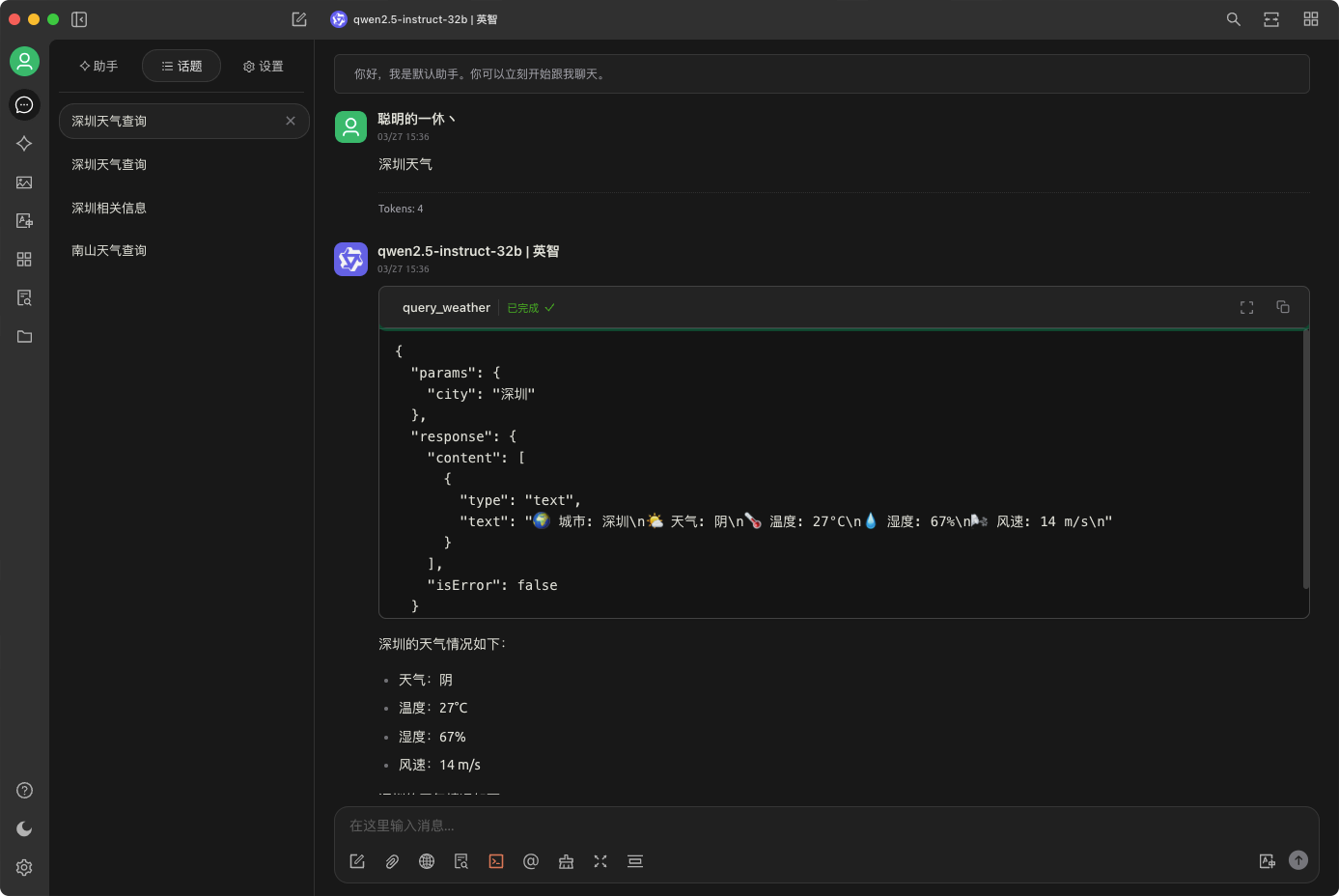Step1. 环境配置
安装 uv
curl -LsSf https://astral.sh/uv/install.sh | sh
Question: 什么是 uv 呢和 conda 比有什么区别?
Answer: 一个用 Rust 编写的超快速 (100x) Python 包管理器和环境管理工具,由 Astral 开发。定位为 pip 和 venv 的替代品,专注于速度、简单性和现代 Python 工作流。
创建项目目录
uv init mcp_server_test
cd mcp_server_test
创建虚拟环境并激活
uv venv
source .venv/bin/activate
安装依赖包
uv add "mcp[cli]" httpx requests
Step2. 实现 MCP Server
创建 weather.py
import requests
from mcp.server.fastmcp import FastMCP
# 初始化 MCP 服务器
mcp = FastMCP("WeatherServer")
HEWEATHER_API_KEY = "你的 key" # ← 填入你的和风天气Key 去https://dev.qweather.com/这里申请
def get_city_id(city_name: str) -> str:
"""根据中文城市名获取和风天气 location ID"""
url = "https://geoapi.qweather.com/v2/city/lookup"
params = {
"location": city_name,
"key": HEWEATHER_API_KEY
}
response = requests.get(url, params=params)
data = response.json()
if data.get("code") == "200" and data.get("location"):
print(data)
return data["location"][0]["id"]
else:
raise ValueError(f"找不到城市: {city_name},错误信息: {data}")
def get_weather(city_name: str) -> str:
"""根据城市中文名返回当前天气中文描述"""
try:
location_id = get_city_id(city_name)
url = "https://devapi.qweather.com/v7/weather/now"
params = {
"location": location_id,
"key": HEWEATHER_API_KEY
}
response = requests.get(url, params=params)
data = response.json()
if data.get("code") != "200":
return f"天气查询失败:{data.get('code')}"
now = data["now"]
return (
f"🌍 城市: {city_name}\n"
f"🌤 天气: {now['text']}\n"
f"🌡 温度: {now['temp']}°C\n"
f"💧 湿度: {now['humidity']}%\n"
f"🌬 风速: {now['windSpeed']} m/s\n"
)
except Exception as e:
return f"查询出错:{str(e)}"
@mcp.tool('query_weather', '查询城市天气')
def query_weather(city: str) -> str:
"""
输入指定城市的中文名称,返回当前天气查询结果。
:param city: 城市名称
:return: 格式化后的天气信息
"""
return get_weather(city)
if __name__ == "__main__":
# 以标准 I/O 方式运行 MCP 服务器
mcp.run(transport='stdio')
Step3. 测试 MCP Server
运行测试
mcp dev weather.py
看到下面输出就启动成功了
mcp dev weather.py
Starting MCP inspector...
Proxy server listening on port 3000
🔍 MCP Inspector is up and running at http://localhost:5173 🚀
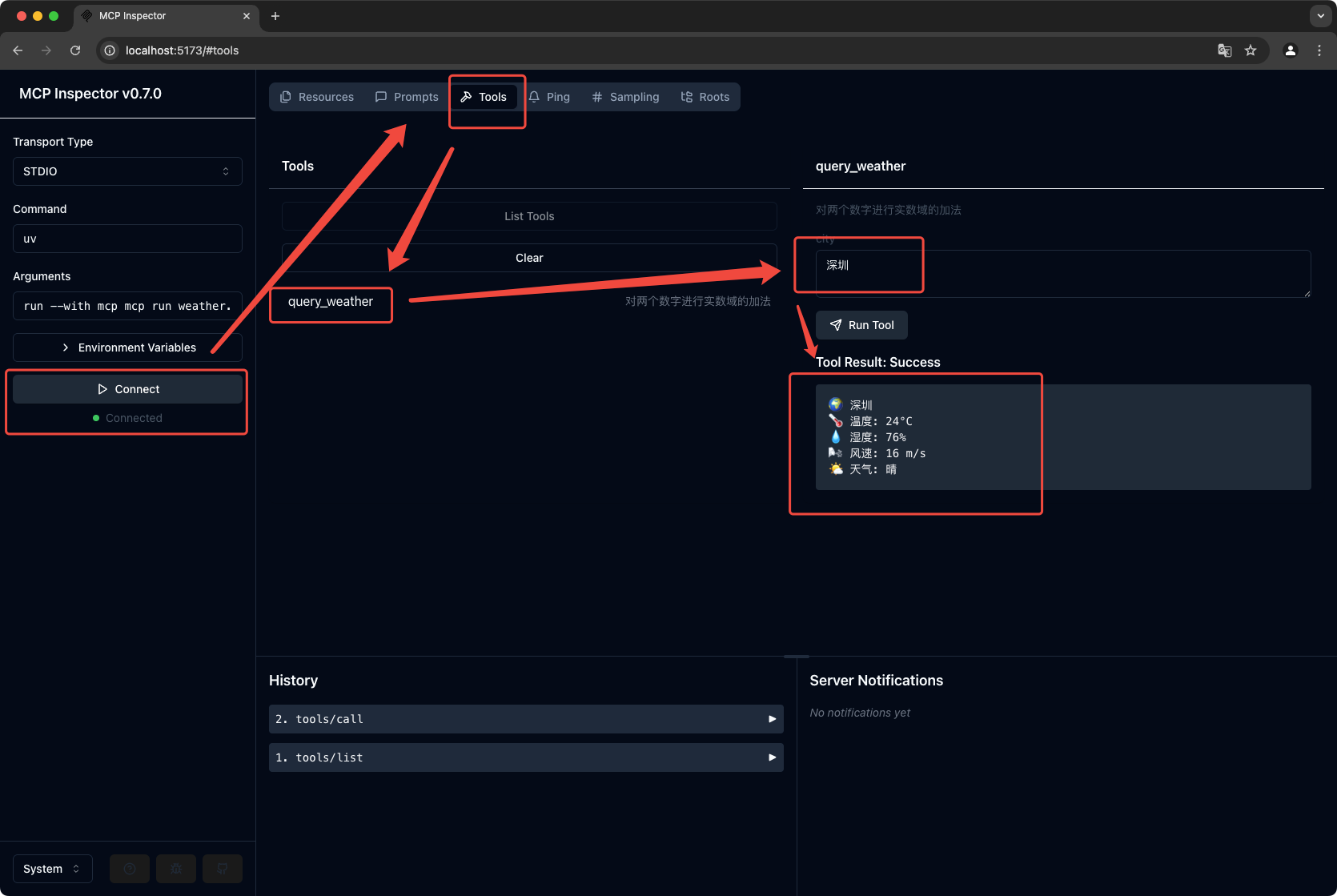
Step4. 修改MCP Server 做成 SSE 服务
import mcp.types as types
import requests
import uvicorn
from mcp.server.lowlevel import Server
from mcp.server.sse import SseServerTransport
from starlette.applications import Starlette
from starlette.routing import Mount, Route
# ================================
# 1) 你的和风天气API Key
# ================================
HEWEATHER_API_KEY = "" # ← 填入你的和风天气Key(例如 "abc123xxxxxx")
# ================================
# 2) 查询天气核心逻辑
# ================================
def get_city_id(city_name: str) -> str:
"""根据中文城市名获取和风天气 location ID"""
url = "https://geoapi.qweather.com/v2/city/lookup"
params = {
"location": city_name,
"key": HEWEATHER_API_KEY
}
response = requests.get(url, params=params)
data = response.json()
if data.get("code") == "200" and data.get("location"):
# 如果成功找到城市
return data["location"][0]["id"]
else:
raise ValueError(f"找不到城市: {city_name},错误信息: {data}")
def get_weather(city_name: str) -> str:
"""根据城市中文名返回当前天气(中文描述、温度、湿度、风速)"""
try:
location_id = get_city_id(city_name)
url = "https://devapi.qweather.com/v7/weather/now"
params = {
"location": location_id,
"key": HEWEATHER_API_KEY
}
response = requests.get(url, params=params)
data = response.json()
if data.get("code") != "200":
return f"天气查询失败:{data.get('code')}"
now = data["now"]
return (
f"🌍 城市: {city_name}\n"
f"🌤 天气: {now['text']}\n"
f"🌡 温度: {now['temp']}°C\n"
f"💧 湿度: {now['humidity']}%\n"
f"🌬 风速: {now['windSpeed']} m/s\n"
)
except Exception as e:
return f"查询出错:{str(e)}"
# ================================
# 3) MCP Server 定义
# ================================
app = Server("mcp-weather")
# (A) 工具调用处理器:根据工具名称选择执行逻辑
@app.call_tool()
async def call_tool_handler(
name: str, arguments: dict
) -> list[types.TextContent | types.ImageContent | types.EmbeddedResource]:
"""
MCP 工具调用处理器
"""
if name == "query_weather":
if "city" not in arguments:
raise ValueError("Missing required argument 'city'")
# 调用上面封装好的 get_weather
weather_info = get_weather(arguments["city"])
return [types.TextContent(type="text", text=weather_info)]
else:
raise ValueError(f"Unsupported tool name: {name}")
# (B) 工具列表:告知 MCP 端都有哪些可调用的工具
@app.list_tools()
async def list_tools() -> list[types.Tool]:
"""
定义可用的 MCP 工具列表
"""
return [
types.Tool(
name="query_weather",
description="查询指定城市天气信息(基于和风天气API)",
inputSchema={
"type": "object",
"required": ["city"],
"properties": {
"city": {
"type": "string",
"description": "要查询的城市名(中文)"
}
},
},
),
]
# ================================
# 4) SSE + Starlette 路由
# ================================
sse = SseServerTransport("/messages/")
async def handle_sse(request):
"""处理 /sse 路由的 SSE 连接,并将其接入 MCP Server。"""
async with sse.connect_sse(
request.scope, request.receive, request._send
) as streams:
# 运行 MCP 应用,处理输入输出
await app.run(
streams[0], streams[1], app.create_initialization_options()
)
starlette_app = Starlette(
debug=True,
routes=[
Route("/sse", endpoint=handle_sse),
Mount("/messages/", app=sse.handle_post_message),
],
)
# ================================
# 5) 启动服务器
# ================================
if __name__ == "__main__":
uvicorn.run(starlette_app, host="127.0.0.1", port=8081)
Step5. 配置 Cherry Studio
安装 Cherry Studio
https://cherry-ai.com/
配置模型 api
https://api.baystoneai.com/
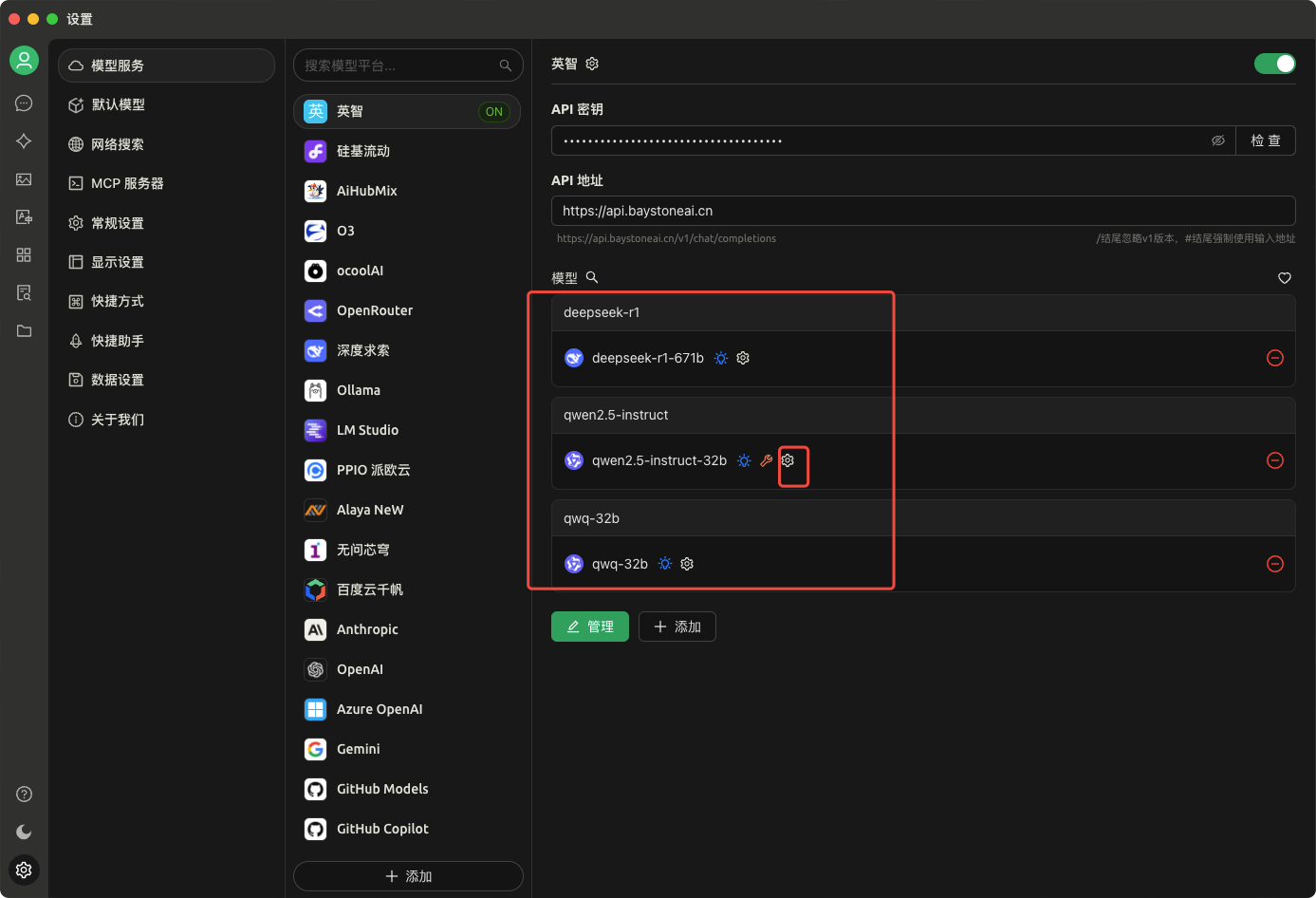
这里需要选择 工具 推理 这两项
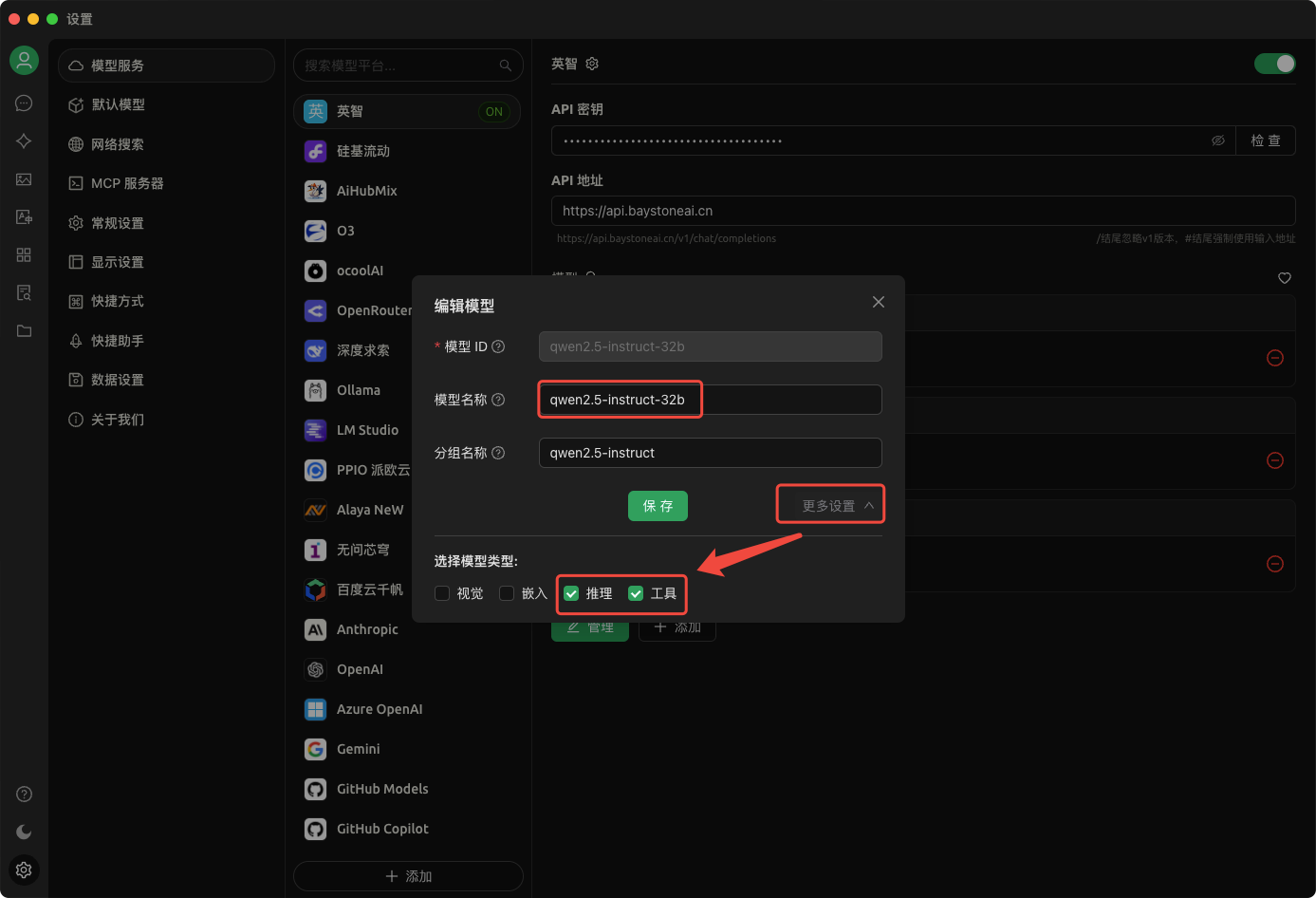
然后是在这里选择你的 MCP 服务
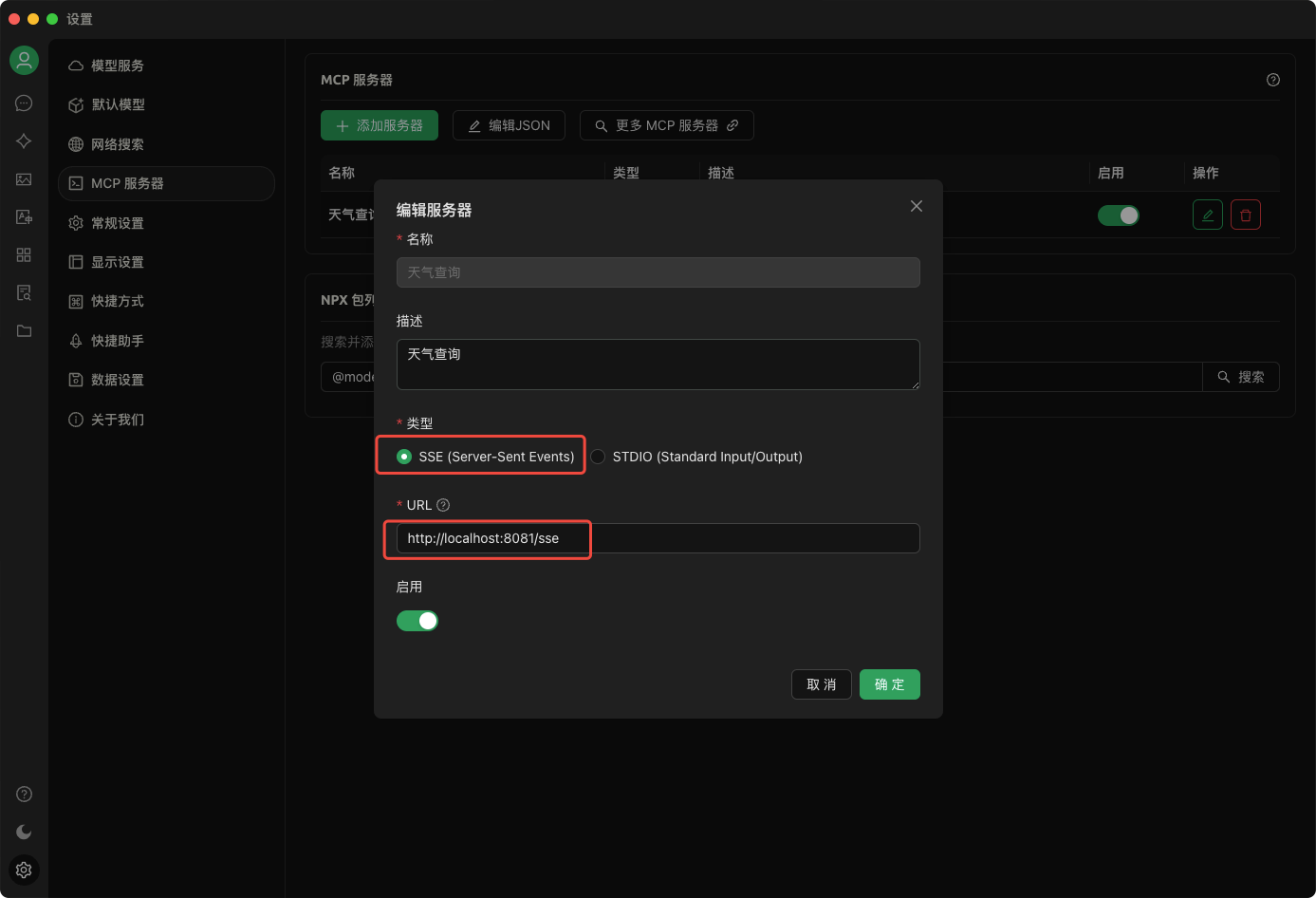
接下来就可以对话啦,让我们看看测试效果
